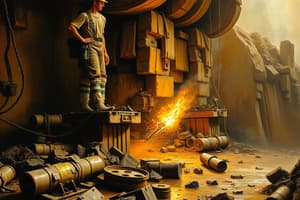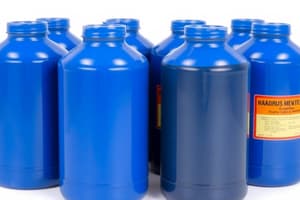Podcast
Questions and Answers
What hazard class do explosives fall under?
What hazard class do explosives fall under?
- Hazard Class Four
- Hazard Class Three
- Hazard Class One (correct)
- Hazard Class Two
What is the primary hazard presented by Class 1.1 explosives?
What is the primary hazard presented by Class 1.1 explosives?
Mass explosion hazard
What type of hazard do Class 1.2 explosives present?
What type of hazard do Class 1.2 explosives present?
Projection hazard
What are examples of Class 1.3 explosives?
What are examples of Class 1.3 explosives?
What safety characteristic defines Class 1.4 explosives?
What safety characteristic defines Class 1.4 explosives?
What is an example of a Class 1.5 explosive?
What is an example of a Class 1.5 explosive?
What defines Class 1.6 explosives?
What defines Class 1.6 explosives?
What hazard class do gases fall under?
What hazard class do gases fall under?
What is an example of a Class 2.1 material?
What is an example of a Class 2.1 material?
What defines Class 2.2 materials?
What defines Class 2.2 materials?
Class 3 is associated with which type of materials?
Class 3 is associated with which type of materials?
What is the flash point of a flammable liquid?
What is the flash point of a flammable liquid?
What characterizes a combustible liquid?
What characterizes a combustible liquid?
What hazard class do solids fall under?
What hazard class do solids fall under?
What is one example of a flammable solid?
What is one example of a flammable solid?
What materials are classified as spontaneously combustible?
What materials are classified as spontaneously combustible?
What characterizes Class 4.3 materials?
What characterizes Class 4.3 materials?
What does Hazard Class 5 encompass?
What does Hazard Class 5 encompass?
Flashcards are hidden until you start studying
Study Notes
Explosives (Hazard Class One)
- Class 1 explosives present mass explosion hazards affecting nearly the entire load instantly.
- Class 1.1 examples: dynamite, mines, wetted mercury fulminate.
- Class 1.2 explosives present projection hazards; examples include detonation cord, bursting charge rockets, flares, and fireworks.
- Class 1.3 explosives primarily pose fire hazards with minor blast or projection hazards; examples: liquid-fueled rocket motors, smokeless powder.
- Class 1.4 explosives have no significant hazard beyond the package; examples: signal cartridges, cap type primers, igniter fuses.
- Class 1.5 explosives are insensitive with a mass explosion hazard; example includes ammonium nitrate fuel oil (ANFO) mixtures.
- Class 1.6 explosives consist of extremely insensitive materials with negligible risk of accidental initiation; examples: low vulnerability military weapons.
Gases (Hazard Class Two)
- Class 2.1 includes flammable gases such as compressed hydrogen, isobutene, methane, and propane.
- Class 2.2 covers non-flammable, non-toxic gases; examples: carbon dioxide, helium, refrigerated liquid nitrogen.
- Class 2.3 encompasses toxic gases posing health hazards; examples: cyanide, diphosgene, phosphine, hydrocyanic acid.
Flammable/Combustible Liquids (Hazard Class Three)
- Flammable liquids have flash points of no more than 140ºF (60ºC); examples: gasoline, methyl alcohol, acetone.
- Combustible liquids have flash points between 140ºF (60ºC) and 200ºF (93ºC); example: fuel oil #6.
Solids (Hazard Class Four)
- Class 4.1 includes flammable solids like wetted explosives and self-reactive materials; examples: phosphorus heptasulfide, magnesium alloys.
- Class 4.2 covers spontaneously combustible materials; examples: sodium sulfide, phosphorus (white or yellow).
- Class 4.3 consists of water-reactive materials that produce flammable or toxic gases upon contact with water; examples: magnesium powder, lithium, calcium carbide.
Oxidizing Solids (Hazard Class Five)
- This class includes materials that can yield oxygen and support combustion.
In Summary
- Understanding the hazard classes and divisions is crucial for the safe handling and transportation of dangerous materials.
- Each class and division has specific characteristics and examples that illustrate their dangers and required precautions during handling.
Studying That Suits You
Use AI to generate personalized quizzes and flashcards to suit your learning preferences.




